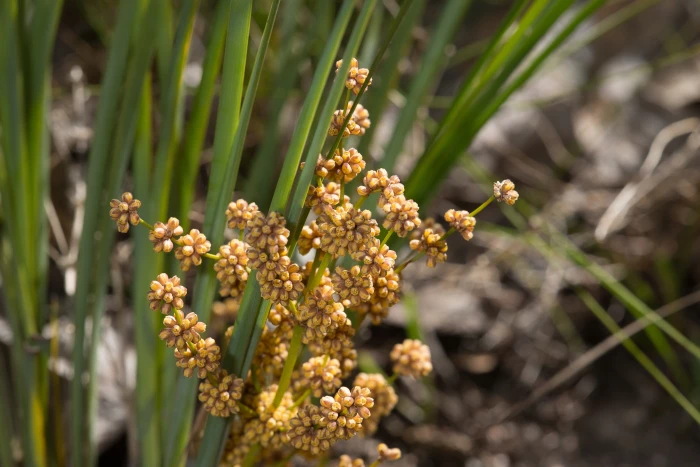Many-Flowered Mat-Rush
(Lomandra multiflora)
Many-Flowered Mat-Rush (Lomandra multiflora)
/
/

Kym Nicolson
CC BY 4.0
Image By:
Kym Nicolson
Recorded By:
Copyright:
CC BY 4.0
Copyright Notice:
Photo by: Kym Nicolson | License Type: CC BY 4.0 | License URL: http://creativecommons.org/licenses/by/4.0/ | Rights Holder: Kym Nicolson | Publisher: iNaturalist | Date Created: 2018-10-12T12:40:08-07:00 |


















































Estimated Native Range
Climate Requirements for Jamestown, New York
| This Plant | Your Site | Plant Suitability for Your Location | ||
|---|---|---|---|---|
| • Precipitation | 5" - 300" | 45" | Aquatic | Aquatic |
| • High Temp. | 69°F - 101°F | 81°F | Your summer temperatures are normal for this plant. | Excellent |
| • Low Temp. | 26°F - 72°F | 15°F | Your winter temperatures may be too cold for this plant | Too cold |
This plant may not grow well at your location - your precipitation is too high.
Summary
Lomandra multiflora, commonly known as Many-Flowered Mat-Rush, is an evergreen perennial grass native to a variety of habitats in Australia, including open grasslands, dry sclerophyll forests, and along watercourses. This species forms dense tussocks with long, flat, rigid, yellowish-green leaves that typically measure 30 to 50 cm in length but can range from 25 cm to 90 cm. It is dioecious, with male and female flowers on separate plants. The flowers, which appear in spring, are creamy yellow and arranged in clusters at the base of the leaves, with 6 petals; the inner petals are yellow and the outer ones reddish-brown. The flowers grow in dense clusters on spikes that can be 25 cm to 75 cm long, with spiky white bracts. Male flowers are smaller, bell-shaped, and grow on branched stems, while female flowers are larger, stalkless, and occur on unbranched spikes. Flowering typically occurs in the summer and fall.
Many-Flowered Mat-Rush is valued for its fire-retardant properties, as it does not ignite easily and can resprout from the base if burned. It is also useful for stabilizing banks and is ideal as a foreground plant in bush gardens, cottage gardens, and rockeries due to its resilience to various conditions, including frost, drought, and brief swampy periods. It is easily propagated through stem tip cuttings. For optimal growth, it prefers full sun to part shade, low to medium water requirements, and soils with slow to medium drainage.CC BY-SA 4.0
Many-Flowered Mat-Rush is valued for its fire-retardant properties, as it does not ignite easily and can resprout from the base if burned. It is also useful for stabilizing banks and is ideal as a foreground plant in bush gardens, cottage gardens, and rockeries due to its resilience to various conditions, including frost, drought, and brief swampy periods. It is easily propagated through stem tip cuttings. For optimal growth, it prefers full sun to part shade, low to medium water requirements, and soils with slow to medium drainage.CC BY-SA 4.0
Plant Description
- Plant Type: Grass
- Height: 1.5-2 feet
- Width: 1-1.5 feet
- Growth Rate: Moderate
- Flower Color: N/A
- Flowering Season: Summer, Fall
- Leaf Retention: Evergreen
Growth Requirements
- Sun: Full Sun, Part Shade
- Water: Low, Medium
- Drainage: Slow, Medium
Common Uses
Bee Garden, Butterfly Garden, Fragrant, Groundcover, Low Maintenance, Street Planting
Natural Habitat
Native to open grasslands, dry sclerophyll forests, and along watercourses in Australia
Other Names
Common Names: Mat Rush, Many-Flowered Mat-Lily
Scientific Names: Lomandra multiflora, Xerotes multiflora, Xerotes multiflora var. typicum
GBIF Accepted Name: Lomandra multiflora (R.Br.) Britten